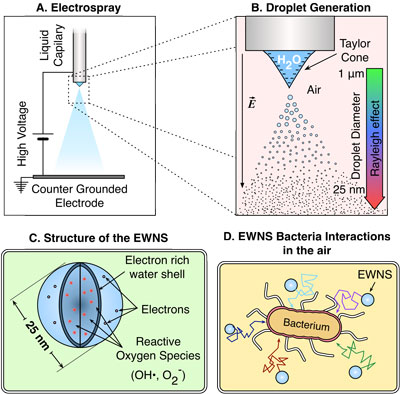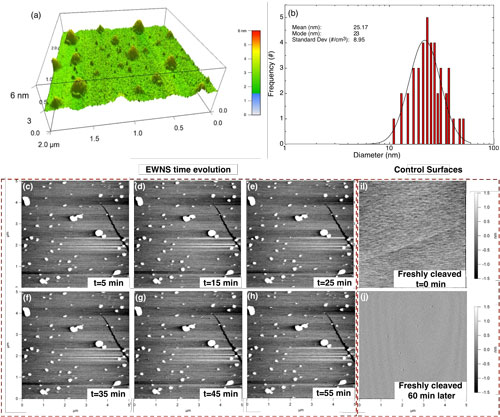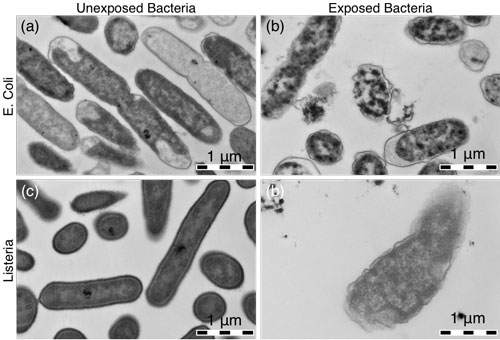| Posted: Mar 16, 2015 | |
Nanotechnology to the rescue: Replacing chemical disinfectants with engineered water nanostructures |
|
| (Nanowerk Spotlight) The burden of foodborne diseases worldwide is huge, with serious economic and public health consequences. The CDC estimates that each year in the USA approximately 48 million people get sick, 128,000 get hospitalized and 3,000 die from the consumption of food contaminated with pathogenic microorganisms. The food industry is in search of effective intervention methods that can be applied from 'farm to fork' to ensure the safety of the food chain and be consumer and environment friendly at the same time. | |
| In the food industry, chemicals are routinely used to clean and disinfect product contact surfaces as well as the outer surface of the food itself. These chemicals provide a necessary and required step to ensure that the foods produced and consumed are as free as possible from microorganisms that can cause foodborne illness. | |
| Food activists are concerned that some of the chemicals used by the food industry for disinfection can cause health issues for consumers. A prime example is the current discussion in Europe about 'American chlorine chicken'. Most U.S. poultry is chilled in antimicrobial baths that can include chlorine to keep salmonella and other bacteria in check. In Europe, chlorine treatment was banned in the 1990s out of fear that it could cause cancer. | |
| Trying to develop chemical free disinfection techniques, researchers at the Center for Nanotechnology and Nanotoxicology at the Harvard T. Chan School of Public Health are currently exploring the effectiveness of a nanotechnology based intervention method for the inactivation of foodborne and spoilage microorganisms on fresh produce and on food production surfaces. | |
| This method, originally reported in Environmental Science: Nano ("A chemical free, nanotechnology-based method for airborne bacterial inactivation using engineered water nanostructures") utilizes Engineered Water Nanostructures (EWNS) generated by electrospraying of water. | |
 |
|
| Figure 1: Synthesis of EWNS. A) Electrospray as means to generate EWNS. B) The applied high voltage results in atomizing the water. Rayleigh effect is reducing the size down to the nanoscale level. C) EWNS properties: an electron rich water shell, encapsulation of ROS generated during the electrospray process. D) EWNS due to their nanoscale nature are highly mobile and can interact with pathogens both in the air and surfaces. (Image: Center for Nanotechnology and Nanotoxicology) (click on image to enlarge) | |
| "Our EWNS possess unique properties," Philip Demokritou, Associate Professor of Aerosol Physics and Director of the Center for Nanotechnology and Nanotoxicology, tells Nanowerk. "They are 25 nm in diameter; remain airborne in indoor conditions for hours; contain Reactive Oxygen Species (ROS); have very strong surface charge (on average 10 electrons per structure) and have the ability to interact and inactivate pathogens by destroying their membrane." | |
| In a study funded by the USDA and just recently published in Environmental Science and Technology ("Inactivation of Foodborne Microorganisms Using Engineered Water Nanostructures (EWNS)"), the efficacy of these tiny water nanodroplets, in inactivating representative foodborne pathogens such as Escherichia coli, Salmonella enterica and Listeria innocua, on stainless steel surfaces and on tomatoes, was assessed showing significant log reductions in inactivation of select food pathogens. | |
 |
|
| Figure 2: The AFM measured size distribution and stability of the EWNS. A) A 3D AFM image of the EWNS as spread on a mica surface. B) The AFM measured size distribution of the EWNS as measured by the AFM. The average diameter was found to be 25.17 nm and follows a lognormal distribution with geometric standard deviation 1.41. C) AFM scan of a freshly cleaved mica surface at t=0 (before spraying the EWNS). D) AFM scan of a control Mica surface (Freshly cleaved mica surface) left in room air during of the experiment (60 minutes). E-J) Progressive scans of the EWNS on mica surface at 10 minutes intervals (up to 55 minutes). There is no apparent difference in the deposited EWNS size over time. The scan area is 5 µm x 5 µm. (Image: Center for Nanotechnology and Nanotoxicology) (click on image to enlarge) | |
| "These promising results could open up the gateway for further exploration into the dynamics of this method in the battle against foodborne diseases," notes Demokritou, who led the study. "More importantly this novel, chemical-free, cost effective and environmentally friendly intervention method holds great potential for development and application in the food industry, as a 'green' alternative to existing chemicals-based inactivation methods." | |
 |
|
| Figure 3: Inactivation mechanism ? outer membrane destruction by oxidation. Unexposed E. coli and listeria bacteria (a) and (c) respectively; E. coli and listeria bacteria exposed to a concentration of 45,000 #/cm3 for 90 minutes (b) and (d) respectively. (Image: Center for Nanotechnology and Nanotoxicology) | |
| He points out that nanotechnology can lead to new useful intervention approaches that can be used in the battle against food borne diseases: "Using water in its engineered nanoscale form can be a 'game changer' – a cost effective approach that can be easily deployed at various intervention points across the 'farm to fork' line. This technology can be used in farms during packaging of fresh produce, during transportation, and in supermarkets as well as in your refrigerators at home." | |
| Demokritou's team is currently further exploring the prospects of this novel nanotechnology approach and working on scaling up the technology which could not only significantly improve inactivation efficiency and decrease the microbial load on the fresh produce but also extend shelf life of produce and reduce the number of cases of foodborne illnesses on consumption. | |
 By
Michael
Berger
– Michael is author of three books by the Royal Society of Chemistry:
Nano-Society: Pushing the Boundaries of Technology,
Nanotechnology: The Future is Tiny, and
Nanoengineering: The Skills and Tools Making Technology Invisible
Copyright ©
Nanowerk LLC
By
Michael
Berger
– Michael is author of three books by the Royal Society of Chemistry:
Nano-Society: Pushing the Boundaries of Technology,
Nanotechnology: The Future is Tiny, and
Nanoengineering: The Skills and Tools Making Technology Invisible
Copyright ©
Nanowerk LLC
|
|
|
Become a Spotlight guest author! Join our large and growing group of guest contributors. Have you just published a scientific paper or have other exciting developments to share with the nanotechnology community? Here is how to publish on nanowerk.com. |
|
